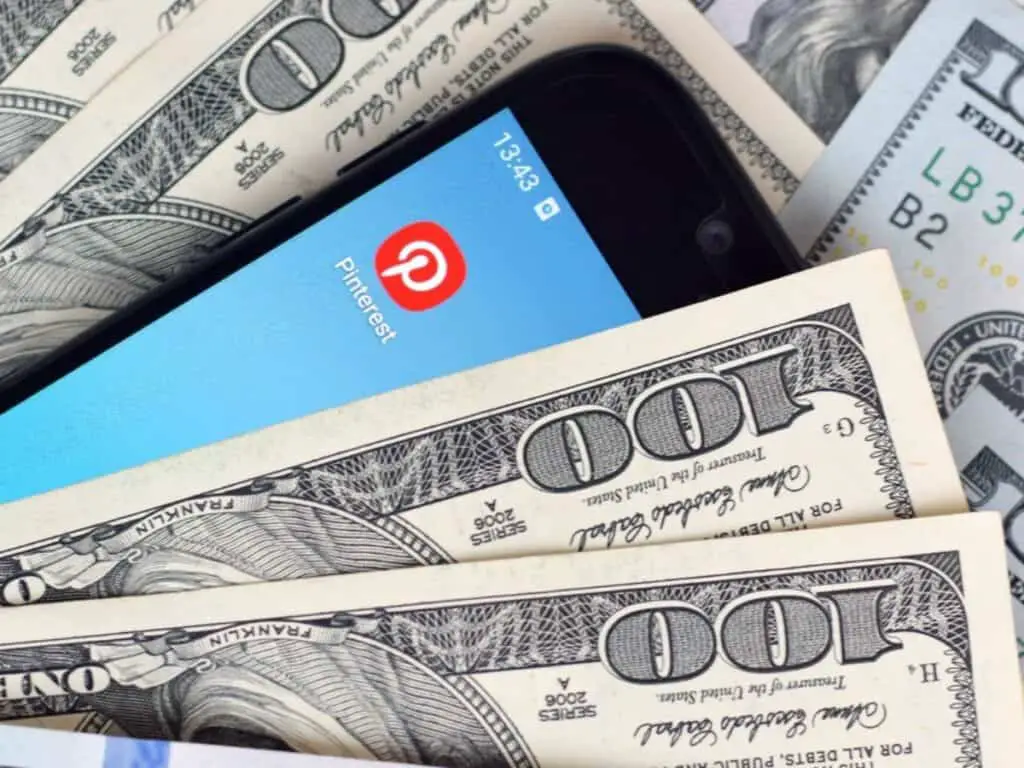Pinterest Affiliate Marketing 101: A Comprehensive Guide to Success in 2024
Pinterest may not be the social network most people immediately think of, but did you know it has 498 million monthly users, increasing each year? That’s why it makes sense that people will want to use it to make money, and affiliate marketing is the perfect way to do that!
Pinterest affiliate marketing involves posting images and engaging content on Pinterest that will draw users, then guiding your visitors to click on affiliate links to products on various platforms. When a user clicks on a link and buys the product, you will earn a commission from that sale.
Pinterest is a visual platform that focuses on photos and images, which makes it easy to showcase products and get engagement. Because users view images related to their interests, you will reach people interested in the products you offer.
Pinterest content can be indexed on search engines, so you can easily drive organic traffic to your pins and affiliate links. Furthermore, the platform offers high community engagement since people can like, share, and comment on posts, increasing your visibility on the platform.
All of these factors make Pinterest better suited to affiliate marketing than other social media platforms. Just bear in mind that Pinterest requires affiliate marketing disclosures to be added to any posts that contain affiliate links, so be sure to add those for legal compliance. More on that in a moment.
Getting Started with Pinterest Affiliate Marketing
Now that you know why getting into Pinterest affiliate marketing is a good idea, let’s see how you can get started.
Creating a Pinterest Business Account
The initial step is to create a Pinterest account for your business. You can create a new business account from scratch or convert an existing personal account to a business account. This will give you access to the Pinterest Business Hub and Pinterest Analytics.
To get started, go to https://pinterest.com/business/create/ and fill in your information. If you want to convert a personal account, log into your account and go to Settings, then Account Management, to find the “Convert Account” option.
Understanding Pinterest’s Guidelines and Policies
It’s vital to understand what Pinterest expects from you as a business page. Read through the Terms of Service and Privacy Policy for more information, but let’s look at some of the highlights:
- You are not allowed to use URL shorteners like bit.ly. Affiliate links must clearly indicate which website they link back to.
- Business owners can only use one Pinterest account to post affiliate links.
- As mentioned, disclosing an affiliate link is not optional.
- Don’t spam. Don’t create large volumes of affiliate pins, or repeat them too often.
Choosing the Right Affiliate Programs for Your Niche
Once all legal and administrative aspects are in place, it’s time to choose the products and services you will market through affiliate links.
Choosing a niche will help you target the right audience. Popular niches include health and wellness, pet care, home décor, personal finance, travel, fashion, beauty, food, DIY, and personal development. It’s best to choose a niche that allows you to create visually stimulating posts that will draw attention.
Once you’ve chosen your niche, you can search for affiliate networks that offer products and services in line with your niche. Amazon and ClickBank are popular options.
Pinterest Affiliate Marketing vs. Traditional Blogging: Pros and Cons
Blogs have long been the go-to option for affiliate marketers and offer several advantages. However, Pinterest also offers some advantages.
Blogs allow more written content, such as product reviews, and a personal blog doesn’t limit how many links you can share.
But blogs require SEO to drive traffic, and maintaining a blog can be expensive. Frequent changes to search engine algorithms can have a detrimental effect on your blog’s traffic. Furthermore, many people read blog posts out of curiosity rather than commercial interest, so you need more traffic to find potential buyers.
Pinterest offers targeted traffic with an interest in the product you’re promoting. You can invest less time and money to get started and keep your page running, and changes to search engine algorithms don’t affect Pinterest content as much.
However, you never have complete control over the platform. It’s more challenging to write detailed content, and sharing too many affiliate links could be seen as spamming.
Many people use a combination of both platforms for optimal results.
How to Build a Solid Foundation

Now you can start building your affiliate marketing business. As with any type of building endeavor, laying the right foundation is crucial.
Identify and Understand Your Target Audience
The first step is deciding who you’re pinning for. Take some time to identify your target audience. Are they young professionals, busy moms, fitness enthusiasts, or fashion lovers? Delve into their interests, problems, and desires.
When you know your audience, you can create content they’ll want to engage with. Consider the pins they would save, share, and click on. Know your audience, then tailor your content to meet their needs.
Conduct Keyword Research for Pinterest SEO
Pinterest is more than a search engine, but it uses search engine technology to serve content to its users. That’s why you should put some effort into your SEO and keyword research.
The easiest way to find good Pinterest keywords is to use the autocomplete function in Pinterest’s search bar. Start by typing a word or phrase from your chosen niche and see what Pinterest recommends because those are the things people search for most. Use those keywords for your pins.
Create High-Quality and Engaging Pinterest Boards
Make your Pinterest boards inviting by ensuring they are high-quality, visually appealing, and relevant to your audience. Use high-resolution images because Pinterest is a visual platform. Add captivating headlines and clear descriptions to your pins to make them stand out.
When your board is impressive, users will scroll for longer, which increases the chances they’ll click on your affiliate links.
Utilize Rich Pins to Enhance Your Affiliate Promotions
Rich pins are a powerful way to add more information to your pins. Adding a rich pin will automatically pull metadata from the website it links to, so users will see more information about the pin to simplify their decision-making process.
Crafting Compelling Content for Pinterest

Create content that’s engaging and compelling enough to keep your visitors hooked.
Design Visually Attractive Pins
Use high-quality images with text overlays that are easy to read. Focus on vertical pins with a 2:3 aspect ratio. They are more visible in the feed and often perform better than others.
You can experiment with different colors and fonts. They should align with your brand, but it’s also important for them to stand out. You don’t have to be a professional graphic designer; tools like Canva can help you create stunning pins.
Write Captivating Pin Descriptions
A beautiful pin will catch people’s eyes, but a well-written description will seal the deal. Make your descriptions clear and compelling. Incorporate relevant keywords, but in a natural way; people don’t like posts with obvious keyword spam that sound unnatural.
Use your descriptions to highlight the product’s value and benefits. People want to know what’s in it for them, so tell them what they will gain from it.
Incorporate Call-to-Actions (CTAs) Effectively
CTAs guide your audience toward taking the next step. A good CTA should be direct and clear, like “Learn more,” “Shop now,” “Get the recipe,” or “Read the full guide.” Place your CTAs strategically in your image and description to maximize their efficiency.
Utilize Storytelling Techniques in Your Affiliate Pins
People love relatable stories! They can help you connect with your audience and make your content memorable.
Share stories that engage your audience and relate to the product you’re promoting. For example, if you’re linking through to a kitchen gadget, share a personal anecdote about how it revolutionized your cooking routine.
Strategies for Growing Your Pinterest Presence
As with any social media platform, you’ll want to expand your reach on Pinterest to increase your engagement.
Pinning Frequency and Best Time to Post
Post consistently. The more often you post (without spamming), the higher the chances for engagement.
The best time to post depends on your target audience. Housewives might engage more during the day, while students will be most active after school. Nights and weekends are usually good times to post.
Engage with Your Audience and Other Pinners
People like to engage with other humans, so it’s important to show there’s an actual person behind your pins. Engage with your audience by responding to comments and messages.
Repin and like others’ content, especially within your niche. These interactions increase your visibility on Pinterest.
Collaborate with Influencers and Group Boards
Identify influencers in your niche and reach out to them for collaborations. Consider guest pinning, joint giveaways, or sharing each other’s content.
You can also join group boards to share your pins with a broader audience and gain more followers.
Promote Your Pinterest Profile on Other Platforms
Use your other social media accounts to promote your Pinterest profile. Share your pins and boards on platforms like Facebook, Instagram, Twitter (X), and LinkedIn to drive traffic to Pinterest.
You can also add a Pinterest follow button to your website. Cross-promotion creates more opportunities for people to discover your pins and links.
Tracking and Measuring Performance

When something is measurable, it can be improved, so it’s important to keep your finger on the pulse of your Pinterest affiliate marketing efforts.
Understand Pinterest Analytics and Metrics
The Pinterest Analytics dashboard provides a wealth of information to help you understand your pins’ performance, but it’s important to understand what each metric means:
- Impressions: How many times people saw your pins in their feeds.
- Engagements: The number of times people clicked, saved, or commented on your pins.
- Close-ups: The number of times people clicked on your pin to see it in more detail.
- Link Clicks: The number of times people clicked through to your affiliate links from your pins.
Pinterest Analytics offers insights into your audience’s demographics, interests, and activity, so you can target your pins more effectively.
Evaluate the Effectiveness of Your Affiliate Pins
Keep an eye on link clicks and conversions to determine which pins are performing well. Look for patterns in the type of content, design, and keywords that work best, and focus on the pins that drive the most traffic and sales.
Adjust Your Strategies Based on Data and Insights
Use the insights from Pinterest Analytics to streamline your strategies. If certain types of pins or keywords perform well, create more similar content. If some pins aren’t performing as expected, determine what might be wrong and adjust accordingly.
Avoiding Common Pitfalls
All businesses have pitfalls, and every business owner makes mistakes. However, knowing about those problems can help you avoid them.
Overpromotion and Finding Balance
You might be tempted to fill your boards with affiliate links to increase your reach, but overpromotion can turn off your audience and get you flagged for spam.
It’s best to focus on providing value. Pin a mix of affiliate links and other useful, non-promotional pins. A good ratio to strive for is 80% valuable, non-promotional content and 20% promotional pins. This balance ensures engagement and builds trust.
Staying Compliant with FTC Disclosure Requirements
Legal compliance can be a pain, but getting your business shut down is even worse. The Federal Trade Commission (FTC) requires that you clearly disclose your affiliate relationships, which means you need to inform your audience when you’re using affiliate links.
Use clear language when doing this. For example, “This post contains an affiliate link. If you make a purchase by following these links, I may earn a commission at no extra cost to you.” Use this disclosure in all pin descriptions, blog posts, and anywhere else you might share affiliate links.
Dealing with Copyright and Legal Issues on Pinterest
It’s important to respect intellectual property rights on Pinterest, so only pin images and content you have the right to use.
This means creating your own pins, using images with permission, or finding licensable images from websites. If you use someone else’s content, give them credit and check that it complies with Pinterest’s guidelines.
How to Leverage Your Pinterest Advertising

In an attempt to appeal to business owners, Pinterest offers ways to promote your pins to others.
Introduction to Pinterest Ads and Promoted Pins
Pinterest Ads are also known as Promoted Pins. These are regular pins that you pay to promote to a larger audience, blending seamlessly with organic content. They can help you reach a targeted audience, increase awareness, and drive traffic to your links.
Pinterest offers various ad formats, including standard pins, carousel pins, video pins, and shopping pins, so you can choose the format that will work best with your campaign goals.
Creating Effective Pinterest Ad Campaigns
As with any ad campaign, it’s important to start with clear objectives. Do you want to increase brand awareness, drive traffic, or boost conversions?
Once you have your goal, use Pinterest’s targeting options to reach your ideal audience. You can target specific demographics, interests, and keywords, and even remarket to users who have engaged with your content before.
Design visually appealing and engaging pins with high-quality images, bold text overlays, and strong CTAs. It should align with your brand and resonate with your target audience.
Then, write compelling pin descriptions that include relevant keywords and a clear CTA. They should be concise and highlight the benefits of clicking through.
Test different versions of your pins to see which ones perform best, then adjust your campaign accordingly.
Budgeting and Bidding Strategies for Affiliate Marketers
Effective budgeting and bidding strategies will maximize your ad spend and help you achieve your goals.
Set a daily or lifetime budget for your campaign based on your overall budget and goals. Start with a modest budget, then scale up when you see results. Keep an eye on your ad spend and adjust your budget to ensure a good return on investment.
Pinterest uses a bidding system for ad placement. You can opt for automatic bidding, where Pinterest sets your bids to get the most clicks or impressions for your budget, or manual bidding, where you choose your maximum bid.
Cost-per-click (CPC) bidding is often a good choice, since you only pay when someone clicks on your ad.
Review your campaign performance regularly. Monitor the impressions, clicks, and conversions to see what’s working and what’s not, and make adjustments as needed.
Scale Your Pinterest Affiliate Marketing Efforts
Once you’ve seen some success with Pinterest affiliate marketing, it’s time to scale your efforts.
Automate Pinning and Scheduling Tools
You can use automatic pinning and scheduling tools like Tailwind or Hootsuite to streamline your process. They let you schedule pins in advance to help maintain consistency.
Tailwind offers features like SmartSchedule, which suggests the best times to post based on your audience’s trends.
Repurpose Content for Continued Success
Boost the value of your existing content by repurposing it. For example, turn blog posts into multiple pins or create infographics from past pins. This allows you to reach different segments of your audience and increases engagement.
You can also update and re-share high-performing pins with new designs or descriptions to keep them relevant and capitalize on their proven success.
Expand Your Affiliate Partnerships
It’s a good idea to join more affiliate programs that align with your niche and audience. This increases your earning potential and provides a wider range of products and services to promote.
Research and join reputable affiliate networks like ShareASale or CJ Affiliate for new opportunities.
Frequently Asked Questions (FAQs)
What is the difference between organic and paid Pinterest affiliate marketing?
Organic marketing uses non-paid methods to draw visitors and potential customers, while paid marketing means your pins are promoted by Pinterest in exchange for a fee. Both have advantages, but organic marketing should always be a key strategy.
Can I use affiliate links directly on Pinterest?
Yes, you can use affiliate links directly on Pinterest in your pin descriptions. Just be sure to disclose your use of affiliate links on each pin that contains one.
How do I avoid getting my Pinterest account suspended for spam?
Don’t overdo your pins, especially ones that include affiliate links. The 80/20 rule is a good guideline to follow.
Is it better to promote physical products or digital products on Pinterest?
You can promote both effectively, as long as you can create engaging visuals of the product or service.
What types of niches are most successful in Pinterest affiliate marketing?
Popular niches often change, but home décor, fashion, makeup, health, parenting, traveling, and food tend to be evergreen.
How do I measure the success of my affiliate marketing campaigns on Pinterest?
The Pinterest Analytics dashboard is a great way to see how effective your marketing is. You can combine that with Google Analytics if you link Pinterest to your own website or blog.
What are some common mistakes to avoid in Pinterest affiliate marketing?
The three most common mistakes are overpromotion (spamming), non-compliance with FTA regulations, and copyright infringements. Don’t overdo your pins, and ensure that your content meets legal requirements.
Bonus: Success Stories from Pinterest Affiliate Marketers
https://www.youtube.com/watch?v=QbjfO3t3u0Q
Christina from the YouTube channel Christina’s Side Hustles decided to try Pinterest affiliate marketing for 90 days to see what kind of results she would get. After converting her personal Pinterest account to a business account, she started consistently creating two to three pins per day, which was difficult at times, but she found that Pinterest’s scheduling system helped her out.
She spent about one full day each month creating and scheduling pins and eventually started earning commissions after the 90 days were over. Unfortunately, it wasn’t much at the time, but through fine-tuning and optimizing her efforts, she was able to generate a decent income that is consistently increasing.
She encountered two specific pitfalls along the way:
- She discovered that it’s not a good idea to list your business as “Online Retail or Marketplace,” because Pinterest doesn’t allow affiliate links on those pages, and she got her account suspended within a day.
- The automation was a great feature, but it also caused her to neglect her optimization efforts. Because she created a month’s worth of pins within a day and scheduled them ahead of time, she didn’t put much effort into using optimization efforts, which led to uninspiring results.
She found that consistent effort and paying attention to Pinterest Analytics are crucial aspects of achieving success as a Pinterest affiliate marketer.
Conclusion
Anyone can be successful at Pinterest affiliate marketing if they choose the right niche, create targeted pins, use high-quality images, and do the necessary research. It’s also important to keep an eye on analytics and metrics, then adjust the campaign as needed.
Affiliate marketing isn’t a get-rich-quick scheme since it takes considerable time and effort to build a system that works and get a sizable following on Pinterest. However, with consistent effort and by following the steps in this guide, you can achieve success and earn a decent monthly income by using your affiliate links on Pinterest!
DID YOU FIND THIS INFORMATION HELPFUL? Share the love on social.
Follow us on Pinterest & Instagram!
ANY OTHER BUSINESS ADVICE WE CAN WRITE ABOUT?
Let us know, email us at: Advice@TheBestBusinessAdvice.com

![]()







